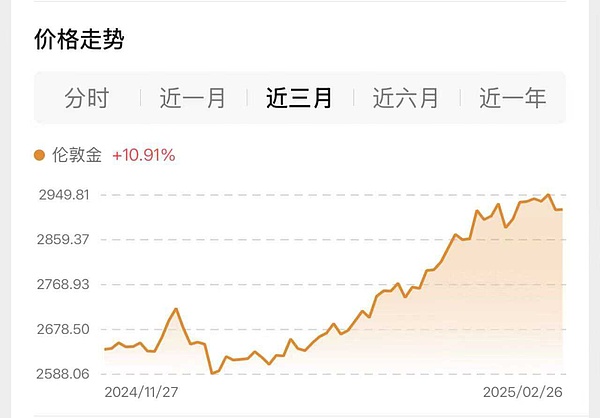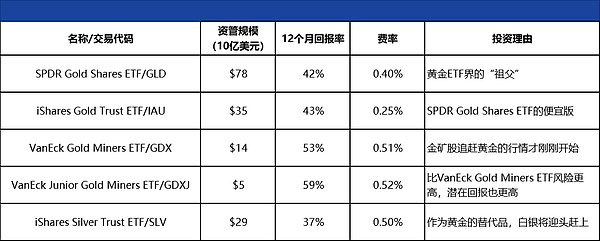Source: Barron's Chinese
Although the international gold price has fluctuated recently, a series of factors may push the gold price to continue to rise. Investors can participate in the rising market through gold ETFs and gold mining stocks. Silver is also expected to rise.
During the Asian trading session on Thursday (February 27), international spot gold fell below $2,900 per ounce, further falling from its historical high.
Analysts believe that this round of pullback is part of the profit-taking cycle, and the long-term bullish factors have not changed. David Meger, head of metal trading at High Ridge Futures, said: "The overall gold price is still on an upward trend. We believe that the price correction is due to investors' profit-taking operations, rather than changes in market sentiment."

The rise in gold is hard to ignore, and a series of factors may push prices to continue to rise.
Gold futures have returned 42% in the past 12 months, more than double the 19% return of the S&P 500, including reinvested dividends. That's a pretty good performance for a commodity that has few real-life uses and produces no income or interest. In addition, gold's gains are for seemingly contradictory reasons: It's considered a defensive asset, but it's rising along with the stock market and the economy; it's priced in dollars, which should move in the opposite direction of the dollar, but it's also defying that rule; and it's often considered an inflation hedge, but its sharp rise comes at a time when inflation is slowing.
However, investors shouldn't rush to sell just because the reasons for the gains are contradictory. "Gold is just my pet rock, but I'm not going to sell it," said David Jane, a portfolio manager at Premier Miton in London. Jane has 5% of his $1 billion in gold. "You can't be sure of its price, and I'm not going to rush to sell it," he said.
Gold has historically been considered a store of value. If you melt down all the gold ever mined in the world, you’d get a cube 25 yards on a side, about the size of one floor of an office building, according to the World Gold Council, and even if miners do their best, they can only increase production by 1% to 2% each year. If supply is relatively fixed, then price changes depend entirely on demand.
Demand has grown dramatically. Central banks have been buying gold as they seek to diversify their reserve assets, with purchases exceeding 1,000 tons for the third consecutive year in 2024, according to the World Gold Council, with China and India buying particularly heavily in the past few years.
Central banks can’t buy without regard to price, but as the value of their holdings rises, that means they can buy more with more confidence, especially when prices fall, said Philip Newman, founding partner of Metals Focus, a consultancy. “The support for gold prices is strong and rising,” Mr. Newman said.
Retail demand for gold is strong around the world. Gold jewelry consumption grew 9% last year, according to the World Gold Council. In China, some insurance companies have begun piloting investments in gold, and demand for gold is strong among households. Others rushing to buy gold may believe that the uncertainty Trump has brought to the world order is expected to drive gold higher, even as stock markets and the economy continue to perform well.
"Gold performs well when global tensions are high," said Krishan Gopaul, an analyst at the World Gold Council.
Gold's sharp rise may also be due to other factors. Expectations that the United States may impose tariffs on gold imports in the near future have pushed up the price of physically delivered gold, which in turn has pushed up the price of borrowing gold. Gavekal Research noted that this created a "short squeeze" in which anyone betting on a fall in gold prices had to suddenly change their bets, further pushing up gold prices. "This means that the fundamentals of the gold bull market remain strong and the technicals are rock solid," Louis-Vincent Gave of Gavekal Research wrote in a note.
Gold's gains may also benefit from people having too much money to put to work, creating a momentum that won't stop, according to Premier Miton's Jane. "I think the positive correlation between gold and stocks shows that excess global liquidity is being sucked up into gold, just as it is being sucked up into U.S. large-cap stocks and anything else that looks attractive right now. This is about speculation, not fear," Jane said.
The momentum is expected to continue. $3,000 may become an important psychological level, but many analysts expect gold prices to rise even higher. In February this year, Goldman Sachs and UBS raised their gold price forecasts for 2025 to $3,100 and $3,200, respectively, while Bank of America analyst Michael Widmer believed that if investment demand grew by 10%, gold prices could hit $3,500. He wrote in a report, "This is a fairly high price, but not impossible to achieve." Data from the World Gold Council showed that driven by European demand, global gold ETFs received $3 billion in inflows in January, compared with net outflows in the same period last year.
Investors can participate in gold's rise through the following ETFs

Source: Morningstar
It's easy to buy gold. You can go to your neighborhood Costco or Walmart and buy gold bars or coins. However, they are more like souvenirs than investments, and they are difficult to sell. A better option is to buy gold ETFs, such as the SPDR Gold Shares ETF, which has an asset management scale of $85 billion and an expense ratio of 0.4%, or the iShares Gold Trust, which has an asset management scale of $38 billion and an expense ratio of 0.25%.
Gold mining stocks are another option to participate in gold's rise. Gold mining companies' profits should grow more or less with the rise of gold, but their stocks have underperformed gold over the past three years, which means that gold mining stocks should catch up. The $14 billion VanEck Gold Miners ETF, which includes multinational gold mining companies such as Newmont (NEM) and Barrick Gold (GOLD), has an expense ratio of 0.51% and has returned 19% this year, including dividend reinvestment, while the SPDR Gold ETF has returned 11%. The $5 billion VanEck Junior Gold Miners ETF, which has an expense ratio of 0.52%, has returned 17%.
For individual stocks, Institutional View analyst Andrew Addison pointed out that Gold Fields (GFI), which operates in Australia, Ghana, Peru and South Africa, has risen 44% this year and is expected to break out of its 30-year trading range. He wrote in a research report, "Don't miss this stock" because its bottom is the largest of all gold mining stocks. Addison also recommends buying shares on a pullback to $18 from a recent $19, predicting they will rise to more than $20. Investors who worry that gold is losing steam after its rally could opt for silver. Silver has more industrial uses than gold, but the two metals have followed similar price trends. Silver futures are up just 6.8% this year, compared with a 10% gain for gold, due to reduced demand for silver in China's manufacturing sector, and could have more upside if China's economic recovery continues. Investors could consider the $14 billion iShares Silver Trust, which has a 0.5% fee. "Silver isn't getting much attention, but if gold hits $3,000, investors might start chasing it," said Metals Focus' Newman.
 Miyuki
Miyuki








